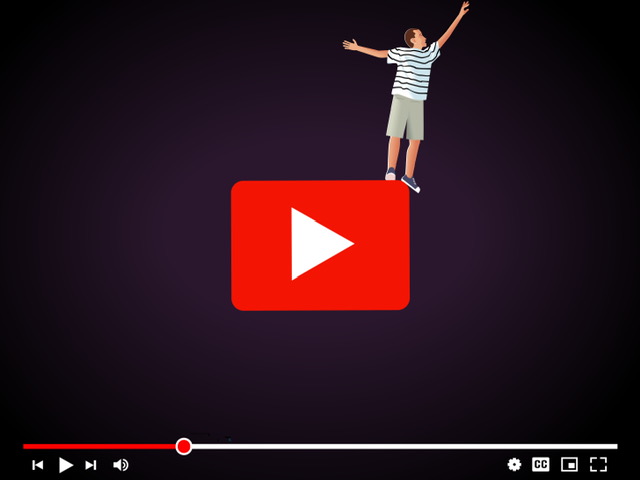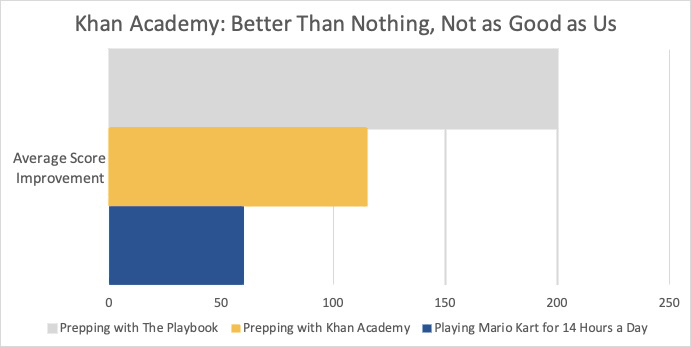The Digital SAT is coming. Get ready to ace it.
The Digital SAT is coming. Get ready to ace it.

Since its founding in 2008, Khan Academy has grown to be the largest provider of online educational tools in the world. Khan Academy features an impressive array of videos and courses, from computer animation to personal finance, and its offerings have been translated into almost 30 languages.
Most important for high school students, Khan Academy is the official preparation tool of the College Board, the organization responsible for the SAT. Khan Academy offers 10 full-length practice tests along with dozens of instructional videos, quizzes, and lessons to help students prepare for the SAT.
And not to be ignored is that Khan Academy offers all of this for free. So what’s not to like?
The fact is, Khan Academy is an effective resource. Its straightforward approach and extensive video library represent a significant improvement over the College Board’s previous efforts to provide “official” test preparation. Students can expect Khan Academy to provide accurate information, professional instruction, and authentic exams.
However, when it comes to maximizing your SAT score, Khan Academy isn’t enough. In fact, Khan Academy’s partnership with the College Board may be as much a weakness as a strength. Consider this analogy: Suppose the IRS announces it has created an “official” tax preparation company. No need to have your “unofficial” CPA or tax attorney search for loopholes. Now the IRS will provide everyone with all the tax advice they could possibly need! Are you going to go with the IRS’s free “official” tax preparation service, or are you going to stick with the advice of experts who have devoted their professional lives to minimizing your liability and maximizing your return?
Khan Academy Teaches Concepts, Not Strategy
So how should students approach Khan Academy? Let’s take a deep dive into how Khan Academy works to get a better sense of the key differences between the College Board’s “official” test preparation and “unofficial” approaches such as our own.
The chief advantage of Khan Academy’s partnership with the College Board is that the learning platform provides students with thousands of math, reading, and writing practice questions that mirror the questions they’ll face on the day of the test.
However—and this is a really, really big however—Khan Academy doesn’t teach test-taking strategies or skills.
While Khan Academy might provide a solid video on the nuts and bolts of “solving linear equations,” the platform fails to explain how tricky SAT questions confuse students. In fact, nowhere in all of Khan Academy’s vast trove of videos will you find a lesson on avoiding the SAT’s notorious trap answers, which is one of the most useful concepts we teach our students.
Almost every question on the SAT includes one answer choice that looks right at first and would be right if not for one little thing, perhaps something as small and seemingly inconsequential as a single word. Students don’t fall for “trap” answers because they misunderstand a question’s underlying concept. They fall for traps because the SAT intentionally sets them. Of course, the College Board will never admit this fact, so Khan Academy operates as if the SAT were simply a test of academic skills and knowledge. This is truly unfortunate, since the ability to recognize trap answers is one of the primary ways students can increase their scores.
Along similar lines, Khan Academy doesn’t teach critical test-taking skills like pacing, educated guessing, and stress management—techniques that “unofficial” prep firms like us have successfully taught for years.
Khan Academy Works Best for the Students Who Need It the Least
Khan Academy’s website enables students to tailor their own program, giving them the ability to study on their own time and at their own pace. While this flexibility works great for some students, it’s inadequate for those who need the most help.
Let’s face it, students with impeccable time-management skills who are able to learn complicated concepts in their free time are already doing well on these tests. The students who need the most help are the ones who have difficulty prioritizing their studies and learning on their own. These students (whom we like to refer to as “normal teenagers”) need more than an online resource to maximize their scores. They need outside help to motivate them and actually teach them how to take the test.
Khan Academy Provides Meager Returns
Khan academy claims that students who use its program for twenty hours see a gain of 115 points, boasting that the 115-point score improvement is “nearly double the average score gain compared to students who don’t use our free test prep.”
That average increase sounds pretty good until you put the number in context. As any well-prepared SAT math student can see, Khan Academy’s claim is less impressive the closer you look. Remember, Khan Academy is bragging that its average increase of 115 points is “nearly double” the average score improvement of students who don’t use its platform. That means that students who don’t use Khan Academy see an average score increase of 55 to 60 points from one SAT exam to the next, which means the value of practicing with Khan Academy for twenty long hours is… less than 60 points.
Now, 50 or 60 points isn’t exactly nothing, but as test prep goes, that’s not a great return on your time investment.

As you can see, Khan Academy’s effectiveness is less than half of ours and only marginally better than playing Mario Kart for fourteen hours a day.
So, Should I Not Bother Using Khan Academy at All?
No.
Though it pains us to admit it, though we would rather do just about anything than concede that the College Board has done anything right, the fact is Khan Academy is a fantastic resource for students seeking a supplement to their SAT prep. It’s a solid platform for drilling concepts you might be shaky on, and it helps to narrow the gap between those who can afford high-caliber test preparation and those who can’t. However, for students looking to improve their scores beyond a paltry 50 to 60 points, Khan Academy simply doesn’t cut it. (Sponsored by The Playbook, the official test prep service of people who know better than to trust the College Board.)

Contact
Schedule a Free Consultation,
9 a.m. – 9 p.m. EST
info@LearnThePlaybook.com
Career and Teaching Opportunities
Inspire@LearnThePlaybook.com
© 2021 Learn The Playbook LLC. All rights reserved
Class 1: MON, JUL 1, 2024, 7:30 PM – 09:00 PM EDT
Class 2: MON, JUL 8, 2024, 7:30 PM – 09:00 PM EDT
Class 3: MON, JUL 15, 2024, 7:30 PM – 09:00 PM EDT
Class 4: MON, JUL 22, 2024, 7:30 PM – 09:00 PM EDT
Class 5: MON, JUL 29, 2024, 7:30 PM – 09:00 PM EDT
Class 6: MON, AUG 5, 2024, 7:30 PM – 09:00 PM EDT
Class 7: MON, AUG 12, 2024, 7:30 PM – 09:00 PM EDT
Class 8: MON, AUG 19, 2024, 7:30 PM – 09:00 PM EDT
Class 1: SUN, JUN 23, 2024, 09:00 AM – 10:30 AM EDT
Class 2: SUN, JUN 30, 2024, 09:00 AM – 10:30 AM EDT
Class 3: SUN, JUL 14, 2024, 09:00 AM – 10:30 AM EDT
Class 4: SUN, JUL 21, 2024, 09:00 AM – 10:30 AM EDT
Class 5: SUN, JUL 28, 2024, 09:00 AM – 10:30 AM EDT
Class 6: SUN, AUG 4, 2024, 09:00 AM – 10:30 AM EDT
Class 7: SUN, AUG 11, 2024, 09:00 AM – 10:30 AM EDT
Class 8: SUN, AUG 18, 2024, 09:00 AM – 10:30 AM EDT
Class 1: MON, JUL 1, 2024, 9:00 AM – 10:30 AM EDT
Class 2: MON, JUL 8, 2024, 9:00 AM – 10:30 AM EDT
Class 3: MON, JUL 15, 2024, 9:00 AM – 10:30 AM EDT
Class 4: MON, JUL 22, 2024, 9:00 AM – 10:30 AM EDT
Class 5: MON, JUL 29, 2024, 9:00 AM – 10:30 AM EDT
Class 6: MON, AUG 5, 2024, 9:00 AM – 10:30 AM EDT
Class 7: MON, AUG 12, 2024, 9:00 AM – 10:30 AM EDT
Class 8: MON, AUG 19, 2024, 9:00 AM – 10:30 AM EDT
Class 1: SUN, JUN 23, 2024, 07:30 PM – 09:00 PM EDT
Class 2: SUN, JUN 30, 2024, 07:30 PM – 09:00 PM EDT
Class 3: SUN, JUL 14, 2024, 07:30 PM – 09:00 PM EDT
Class 4: SUN, JUL 21, 2024, 07:30 PM – 09:00 PM EDT
Class 5: SUN, JUL 28, 2024, 07:30 PM – 09:00 PM EDT
Class 6: SUN, AUG 4, 2024, 07:30 PM – 09:00 PM EDT
Class 7: SUN, AUG 11, 2024, 07:30 PM – 09:00 PM EDT
Class 8: SUN, AUG 18, 2024, 07:30 PM – 09:00 PM EDT
100 THINGS MOST TEENAGERS WOULD RATHER DO THAN PREP FOR THE SAT OR ACT